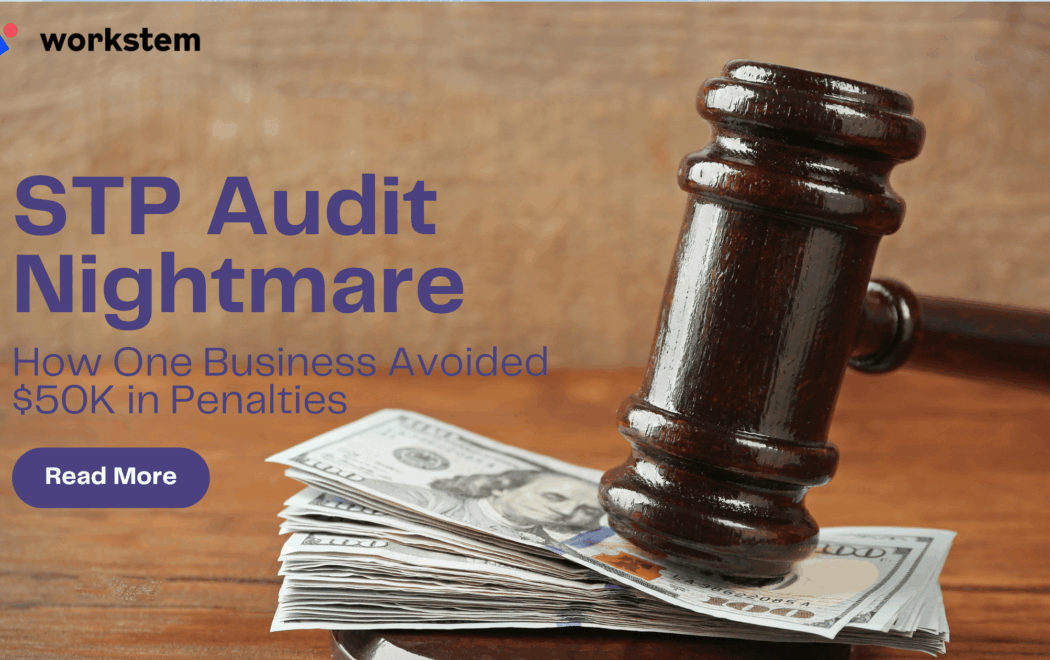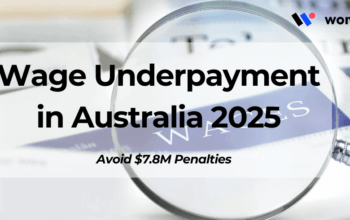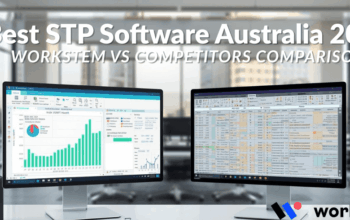An ATO Single Touch Payroll (STP) audit can be a business owner’s worst nightmare. For Australian companies with complex payroll needs, the risk of non-compliance looms large—threatening massive penalties, reputational damage, and operational disruption.
This real-world case study reveals how a prominent hospitality group faced a gruelling 6-month ATO audit and successfully avoided $50,000 in penalties through proactive STP compliance management with Workstem.
The Case: A Hospitality Group Facing Major ATO Scrutiny
Our client, a multi-venue hospitality group operating across Sydney and Melbourne, employed over 200 staff under complex award structures including:
- Hospitality Industry (General) Award
- Restaurant Industry Award
- Multiple enterprise agreements across venues
The trigger for the ATO audit came from discrepancies in their historical STP Phase 1 reporting, specifically around:
- Misclassification of ordinary hours vs. overtime
- Inaccurate reporting of allowances and penalties
- Inconsistent superannuation calculations
- Late submissions from previous years
With potential penalties reaching $50,000 and the threat of public naming, the group faced a critical compliance emergency.
The Audit Process: A 6-Month Investigation Timeline
The ATO’s comprehensive audit followed a rigorous timeline:
Month 1-2: Initial Documentation Requests
- The ATO requested three years of payroll records, including:
- STP event-by-event reporting history
- Employee classification records
- Time and attendance data
- Superannuation payment records
Month 3-4: Employee Interviews & Verification
- ATO officers conducted random employee interviews to verify:
- Actual hours worked vs. hours reported
- Correct application of award rates
- Payment timing and accuracy
Month 5-6: Penalty Assessment & Calculations
The ATO identified multiple discrepancies and began calculating potential penalties for:
- Late STP submissions
- Incorrect reporting
- Superannuation shortfalls
Defense Strategy: How Proper Documentation Saved the Day
The hospitality group’s investment in Workstem’s automated STP compliance platform proved to be their most valuable defense. Our system provided:
- Complete Audit Trail Documentation
- Automated record-keeping of every STP submission
- Version history of all payroll changes
- Employee consent and acknowledgment records
Real-time Award Interpretation
- Automated application of correct award rates
- Accurate overtime and penalty calculations
- Detailed breakdown of every pay component
Comprehensive Reporting Capabilities
- Instant generation of historical compliance reports
- Side-by-side comparison of actual vs. reported data
- Superannuation reconciliation reports
Resolution Outcome: From $50K Threat to 95% Reduction
Through systematic documentation and evidence-based defense, the hospitality group achieved:
- 95% reduction in penalties – from potential $50,000 to final $2,500
- Zero public naming – avoiding reputational damage
- No employee back-payment requirements – all payments were verified as correct
Future compliance guarantee – with implemented systems
The ATO specifically noted the “comprehensive and professional documentation” as a key factor in their decision to substantially reduce penalties.
Critical Audit Preparation Steps Every Business Should Take
Based on this case study, we recommend these essential preparation steps:
- Implement Automated STP Compliance:Use Workstem’s ATO-approved platform to ensure perfect reporting from day one.
- Maintain Meticulous Records:Keep detailed records of all STP submissions, employee classifications, and award interpretations.
- Conduct Regular Self-Audits:Use Workstem’s reporting tools to regularly verify your compliance status before the ATO does.
- Train Your Team Thoroughly:Ensure payroll staff understand STP Phase 2 requirements and classification rules.
- Establish an Audit Response Plan:Designate responsible persons and have documentation protocols ready.
How Workstem Helps Manage STP Obligations?
Ensure your business remains compliant effortlessly. Let Workstem’s automated payroll and integrated STP Phase 2 reporting handle the complexity for you. Explore Workstem’s STP Solution today and ensure peace of mind with every pay run.
Simplify award interpretation and payroll processing with Workstem, the all-in-one workforce management & payroll software designed for every industry.Workstem is an ATO-approved STP Phase 2 solution that simplifies compliance by automating the entire process:
- Built-in Validation: Workstem’s software is designed with the correct STP Phase 2 fields and categories, guiding you to enter data correctly and reducing errors.
- Seamless Integration: As an all-in-one platform, Workstem integrates time & attendance, payroll, and STP reporting. This eliminates manual data entry between systems, ensuring the data you report is accurate and consistent.
- Easy Submissions: Reporting is done with a single click at the end of each pay run, with immediate confirmation from the ATO.
- Simplified Finalisation: The year-end finalisation process is streamlined and can be completed in minutes.
Choose from our Standard or Advanced plan to suit your business needs, and stay Fair Work compliant with confidence.
FAQs About the Single Touch Payroll (STP)
Q1: What is Single Touch Payroll (STP) in simple terms?
A: Single Touch Payroll (STP) is a mandatory Australian government initiative that requires businesses to report their employees’ payroll information—such as salaries, wages, pay-as-you-go (PAYG) withholding, and superannuation—to the Australian Taxation Office (ATO) directly from their payroll software each time they run payroll. It’s “single touch” because the reporting happens with a single action at the same time as you pay your staff.
Q2: Who needs to report through STP?
A: Essentially, all Australian employers must report through STP.If you have even one employee, you are generally required to use STP.
Q3: What is the difference between STP Phase 1 and STP Phase 2?
A: STP Phase 2 expands the reporting requirements introduced in Phase 1. The key difference is the level of detail provided to the ATO.
- STP Phase 1 reported total amounts for key figures like gross earnings and tax withheld.
- STP Phase 2 requires a detailed, disaggregated breakdown of an employee’s income (e.g., separating salary, overtime, allowances, and leave payments).
Q4: What are my ongoing STP reporting obligations?
A: Your main ongoing obligations are:
- Report Each Pay Event: Submit the required data to the ATO on or before every pay day.
- Year-End Finalisation: Finalise your data by 14 July each year. This declares the information for the financial year is complete and correct. This replaces the need to provide payment summaries to your employees.
- Keep Records Accurate: Ensure employee details in your payroll software are always up-to-date (e.g., tax declarations, super fund choice).
Q5: I missed the STP Phase 2 migration deadline. What should I do?
A: You should take action immediately:
- Contact your software provider to start the transition process.
- Lodge a voluntary disclosure with the ATO to explain the delay. The ATO generally looks favorably upon businesses that come forward voluntarily and may provide you with a compliance plan or extra time to transition.
- Ensure you are using an ATO-approved STP Phase 2 solution, like Workstem, to become compliant.
Q6: How does STP help with my employees’ Superannuation?
A: While STP itself does not pay your super, it reports the liability for superannuation to the ATO each payday. This allows the ATO to better monitor and ensure that employers are meeting their super guarantee obligations on time. You still need to pay your super contributions to your employees’ funds by the quarterly due dates.
Q7: Does STP change when I have to pay my tax and super?
A: No. STP is a reporting system, not a payment system. The due dates for paying the PAYG withholding tax you report to the ATO and your super guarantee contributions to funds remain unchanged.
Q8: What happens if I make a mistake in my STP report?
A: Mistakes can be fixed. If you discover an error in a past submission, you can make a STP amendment through your payroll software. You simply correct the information in your system and submit a revised update to the ATO. It’s important to correct errors as soon as you find
Q9: Where can I find official information from the ATO?
A9: The best source of truth is always the official ATO website. You can find comprehensive guides, news, and resources on their Single Touch Payroll for employers page.
Book a free demo with our payroll experts and experience how Workstem can streamline your payroll and workforce operations.
Read More:
STP Phase 2 Australia: Post-Migration Compliance Guide & Requirements
Single Touch Payroll 2025: Everything Australian Employers Need to Know
Avoiding STP Penalties 2025: ATO Audit Guide & Risk Prevention
Guide to Single Touch Payroll for Closely Held Payees








